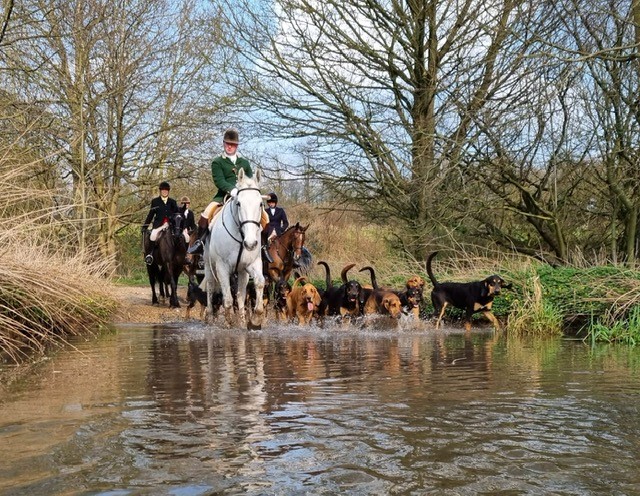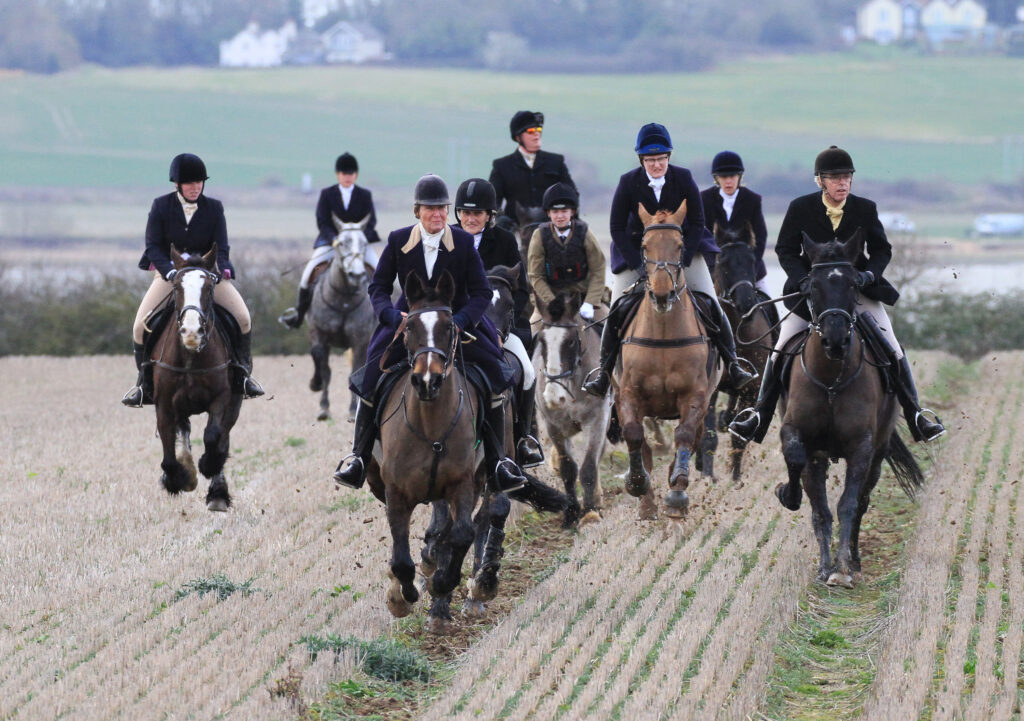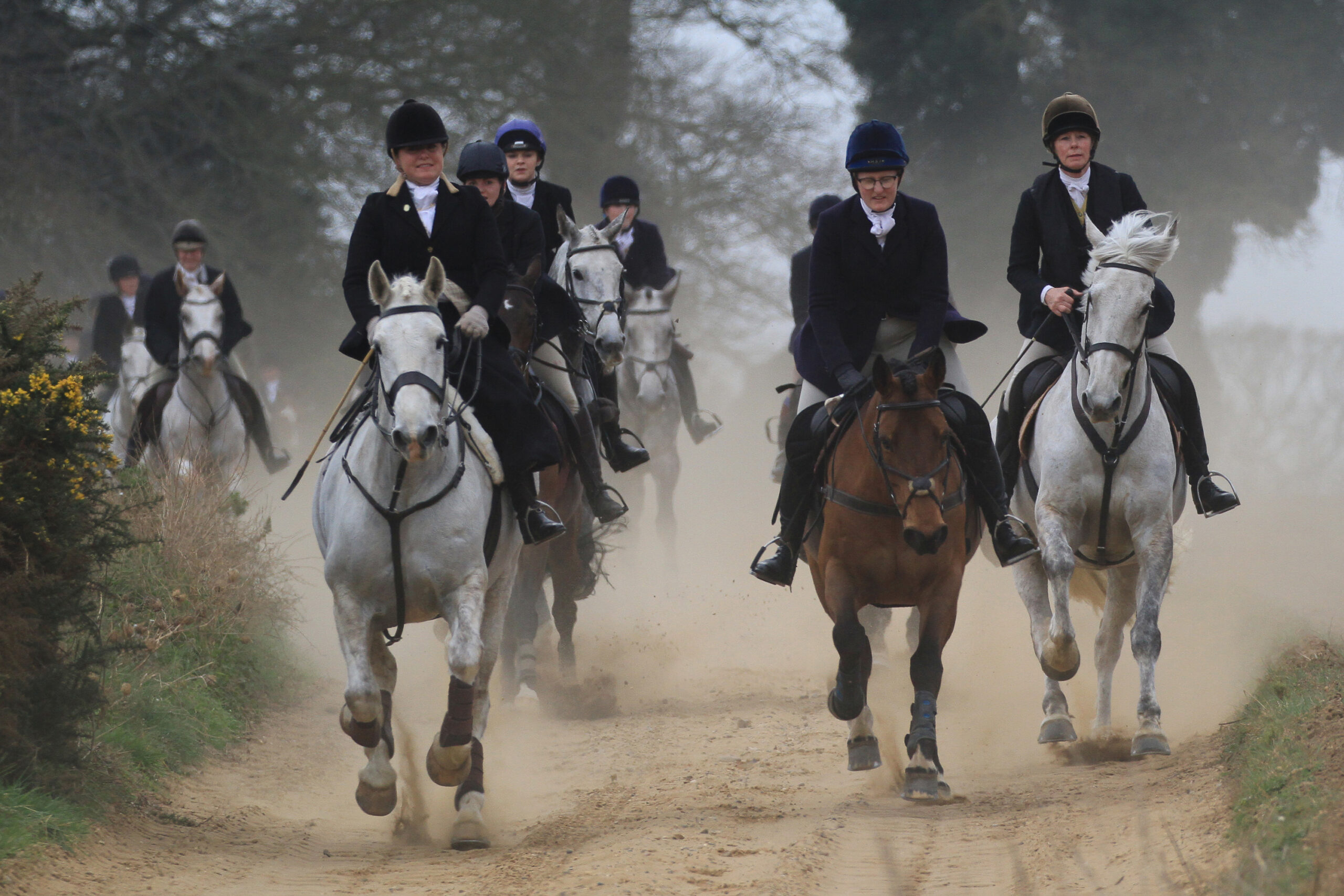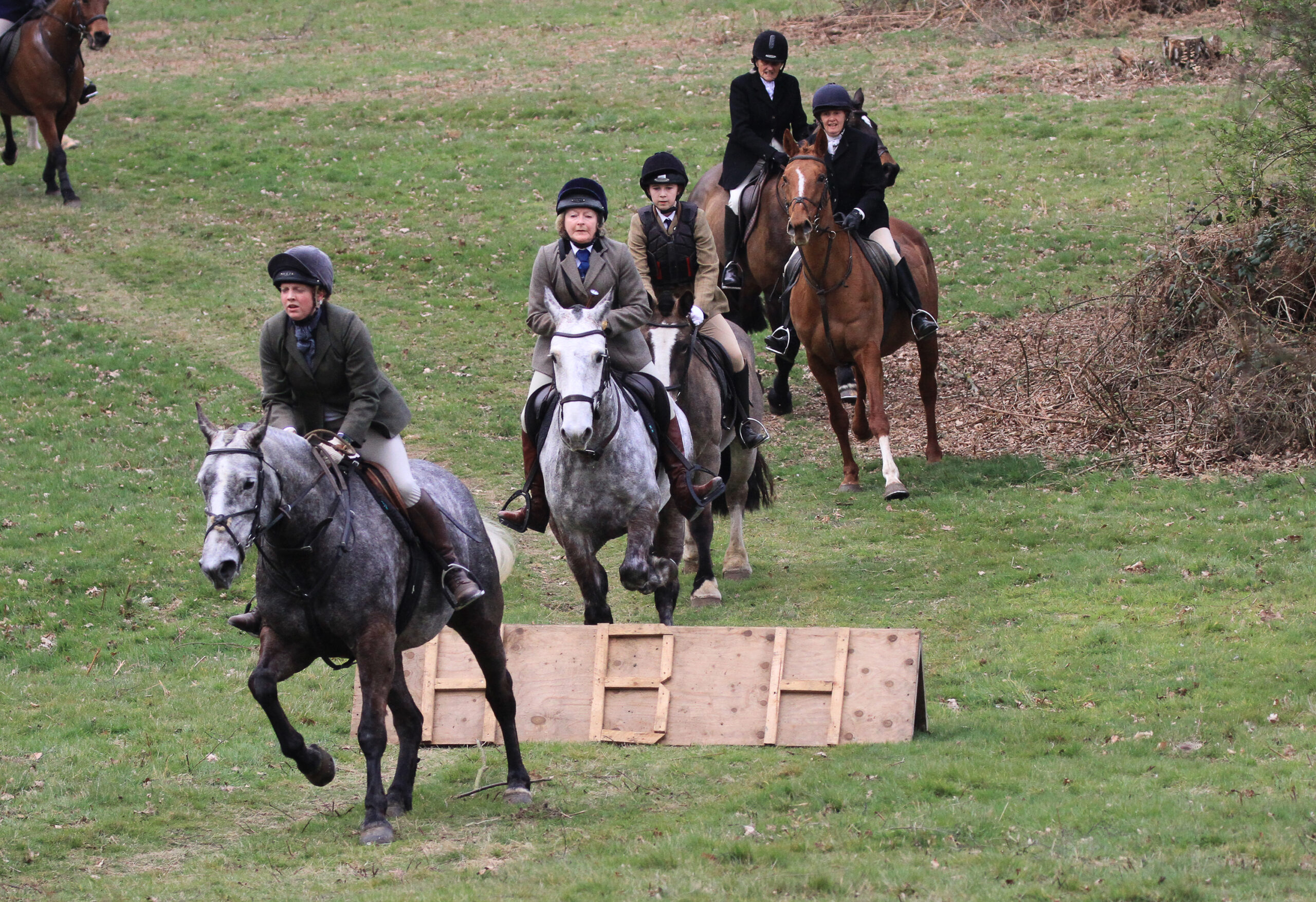Prior to moving off


What to wear
You should always wear a hard hat, which conforms to current safety standards, and which is properly fitted and secured.
If you are new to hunting, it is acceptable for the first few times to wear whatever you feel comfortable in, provided that both you and your horse are clean, tidy and smart. Without our landowners we cannot hunt – so we do our best to be well turned out for them.
For meets prior to opening meet (which are called “early mornings” or “Autumn hunting”) the correct dress is a tweed jacket, a shirt and tie or a coloured stock, buff breeches, black or brown boots or short boots and tidy gaiters, and gloves.
For opening meet and beyond, the proper dress is as above, but with a black hunt coat for gentlemen and a black or blue coat for ladies, and a hunting tie (stock).
Junior riders may ride in tweed all season round.
Raincoats are acceptable if the weather necessitates it.
Visitors from other packs, or military visitors, may wear their own hunting livery or uniform.
Do wear a form of body protection that is usual to you, either over or under your hunting attire.
Getting to the meet
Please familiarise yourself in advance with where the meet is, where you should park and how to get there. Please note that the advertised postcode will not always coincide precisely with where the parking is, particularly in remote areas. We will advertise as early as we can on Facebook the What-3-Words location for the parking. It is usually more accurate to navigate to this. Please remember that we are permitted to hunt only by the kindness of the landowner or farmer, and do not drive over or park on any areas other than those advertised, even if it seems OK to do so: the landowner or farmer may have their own reasons for wanting you to stay off them.
Allow yourself plenty of time to get to the meet, get your horse ready, and get on. There are sometimes refreshments available prior to moving off. We recommend that you aim to be at the meet 30 minutes beforehand, which will provide an opportunity to chat to others, pay your cap (if you have not used our pre-booking system), and settle yourself and your horse.
Please note that the advertised meet time is the time the huntsman and hounds will move off, so please make sure you are ready by then.
At the meet
If you are new to hunting, or to the Hamilton Bloodhounds, you are very strongly advised not to come to the Meet alone but to bring a friend or relative who can be on hand to help, and in the event of an injury, be with you and take you and your horse home.
If it is your first time out, then if possible, please identify yourself to the Hon Secretary (or failing that any Master, officer or committee member who may be out), who will show you who’s who, and will be able to answer any questions you may have.
The Huntsman will be in a green coat, and will be assisted by two or more whippers-in, whose job it is to ensure that the hounds remain together and on the line. They will be busy with hounds and quarry. Please do not approach either them or the hounds until the day’s hunting is over.
The Field Master of the day will give a short address before hounds move off. This will include important instructions for the day, which it is essential to listen carefully to. So please make sure that you are close enough to hear, that you listen carefully and that you adhere to any instructions that are given. The Field Master will then invite the Huntsman to ‘move off’. The Huntsman will blow his horn, and he and the whips will take the hounds to the first line. This will usually involve a hack of anywhere between ten minutes and half an hour.
At the end of each line, hounds will be given water and a rest before hacking to the next line.
Horses
Turnout
Your horse should be clean and tidy, and have safe and properly fitting tack. You should have a plain Numnah (no bright colours or bling!). It is not necessary to plait pre-opening meet, but it is usual to plait at and after opening meet, save that cobs may have hogged manes, and native ponies may have natural manes.
Newcomers or Vices
Please do not bring a horse which you know or have any reason to believe may be unsafe or unsuitable for hunting in any respect. If your horse starts to behave dangerously or inappropriately or in a manner which may result in injury to you or any other persons, horses or hounds, please immediately leave the field.
In particular, if your horse is a known kicker, do not bring it hunting. If your horse may kick then it must wear a red ribbon and stay at the back of the field at all times. It is your responsibility to keep it well away from horses and hounds: do not leave it up to others to stay away from you.
If your horse is new to hunting, it must wear a green ribbon for the first few times you bring it out, until such time as you are confident that it will behave safely and appropriately both as regards hounds and in the field. Please give yourself plenty of space, and if you need to, stay at the back. Although others in the field will be aware that your horse is new to hunting, it is your responsibility to do your best to stay away from others: do not simply rely on them staying away from you.

In The Field
Behaviour in The Field
Please remain behind the Field Master at all times.
Any instructions or messages must be passed up or down the field without delay.
Do not ride too close to the horse in front, and do not use it as an aid to stopping.
Ensure that you stay well out of the way of the Huntsman and whips, and allow them to pass when necessary.
Please ride only where instructed to do so. Do not take your own line. Do not ‘go for a jolly’ over other areas just because they look inviting.
Please remember that we are only able to hunt because the landowner has allowed us to do so. You must be courteous at all times to the landowner, and you must treat the land with respect.
Please allow plenty of room and space for horses to jump. If your horse is a sticky jumper, don’t block the fence or ditch by trying to jump again and again. Let other horses through to avoid dangerous bottle necking. Move to the side quickly, and have another go once it is safe to do so.
If somebody falls, and you are one of the nearest riders, please wait and provide assistance where it is safe and possible to do so, summon back-up or contact the emergency services where necessary, and remain with the faller until they are safely remounted or help arrives.
If you need to go home, please stick to bridleways and roads as far as possible and do not cross parts of the land that we have not been given permission to hunt over.
Hounds
Please keep your horse at a safe distance from hounds, and always turn your horse to face hounds and hunt staff as they pass.
Do not over-ride a hound. If a hound is trailing behind, and near the mounted field, give it plenty of space and allow it to pass. If a hound stops to ‘empty’, please wait to allow this to happen before moving on.
How fast do we go?
The type of country and strength of scent will generally determine the speed of travel. In tighter country the quarry will run tighter lines so the pace will be slower, and in open country there will be a faster pace.
All riders are encouraged to place themselves in the field according to their preference and ability. Should you wish to go at a slower pace, then placing yourself at the back of the field is preferable.
How fit does my horse need to be?
Prior to opening meet, the meets will tend to be shorter, with fewer lines and less distance to cover – so this is an ideal way to get both horse and rider fit. If you are coming after opening meet, then your horse will need to be reasonably fit, as we can cover approximately 10 to 15 miles in total (with rests).
Emergency Card
Please ensure that you complete and carry with you at all times a Rider Emergency card. One can be downloaded from the Forms section or obtained from the Secretary on request.
The Public
Always smile and be polite to all members of the public – even if it is not reciprocated!
If you hear a shout of ‘Car Please’ then move into the near side of the road. Always thank the driver and smile.
Car and foot followers
Car and foot followers are very welcome at our meets. However, please remember that we are hunting the scent of a human, and take care not to go near hounds or cross the scent line. If not, you may disrupt the hounds hunting line – and they may start hunting you!
Hunting etiquette
The purpose of hunting etiquette is to ensure that everyone has a safe and fun day, and that our landowners are happy. A downloadable copy of our etiquette card may be found in the Forms section. Please read it carefully before coming out.

Disclaimer
By coming out with us, either hunting or at any of our riding events, you agree to the terms and conditions on our disclaimer form. There is a copy in the Forms section, or one is available from the secretary on request. Please ensure that before you arrive at one of our meets, or other riding events, for the first time, you have carefully read, understood, and given us a signed and dated form.


